## An ffmpeg and SDL Tutorial
Part 1
Part 2
Part 3
Part 4
Part 5
Part 6
Part 7
Part 8
End
ffmpeg is a wonderful library for creating video applications or even general
purpose utilities. ffmpeg takes care of all the hard work of video processing
by doing all the decoding, encoding, muxing and demuxing for you. This can
make media applications much simpler to write. It's simple, written in C,
fast, and can decode almost any codec you'll find in use today, as well as
encode several other formats.
The only prolem is that documentation is basically nonexistent. There is a
single tutorial that shows the basics of ffmpeg and auto-generated doxygen
documents. That's it. So, when I decided to learn about ffmpeg, and in the
process about how digital video and audio applications work, I decided to
document the process and present it as a tutorial.
There is a sample program that comes with ffmpeg called ffplay. It is a simple
C program that implements a complete video player using ffmpeg. This tutorial
will begin with an updated version of the original tutorial, written by Martin
Bohme (I have stolen liberally borrowed from that work), and work from there
to developing a working video player, based on Fabrice Bellard's ffplay.c. In
each tutorial, I'll introduce a new idea (or two) and explain how weimplement
it. Each tutorial will have a C file so you can download it, compile it, and
follow along at home. The source files will show you how the real program
works, how wemove all the pieces around, as well as showing you the technical
details that are unimportant to the tutorial. By the time we are finished, we
will have a working video player written in less than 1000 lines of code!
In making the player, wewill be using SDL to output the audio and video of
the media file. SDL is an excellent cross-platform multimedia library that's
used in MPEG playback software, emulators, and many video games. You will need
to download and install the SDL development libraries for your system in order
to compile the programs in this tutorial.
�
This tutorial is meant for people with a decent programming background. At the
very least you should know C and have some idea about concepts like queues,
mutexes, and so on. You should know some basics about multimedia; things like
waveforms and such, but you don't need to know a lot, as I explain a lot of
those concepts in this tutorial.
There are printable HTML files along the way as well as old school ASCII
files. You can also get a tarball of the text files and source code or just
the source. You can get a printable page of the full thing in HTML or in text.
**UPDATE:** I've fixed a code error in Tutorial 7 and 8, as well as adding
-lavutil.
Please feel free to email me with bugs, questions, comments, ideas, features,
whatever, at _dranger at gmail dot com_.
_**>>** Proceed with the tutorial!_
## Tutorial 01: Making Screencaps
Code: tutorial01.c
### Overview
Movie files have a few basic components. First, the file itself is called a
**container**, and the type of container determines where the information in
the file goes. Examples of containers are AVI and Quicktime. Next, you have a
bunch of **streams**; for example, you usually have an audio stream and a
video stream. (A "stream" is just a fancy word for "a succession of data
elements made available over time".) The data elements in a stream are called
**frames**. Each stream is encoded by a different kind of **codec**. The codec
defines how the actual data is COded and DECoded - hence the name CODEC.
Examples of codecs are DivX and MP3. **Packets** are then read from the
stream. Packets are pieces of data that can contain bits of data that are
decoded into raw frames that wecan finally manipulate for our application.
For our purposes, each packet contains complete frames, or multiple frames in
the case of audio.
At its very basic level, dealing with video and audio streams is very easy:
10 OPEN video_stream FROM video.avi
20 READ packet FROM video_stream INTO frame
�
30 IF frameNOT COMPLETE GOTO 20
40 DO SOMETHING WITH frame
50 GOTO 20
Handling multimedia with ffmpeg is pretty much as simple as this program,
although some programs might have a very complex "DO SOMETHING" step. So in
this tutorial, we're going to open a file, read from the video stream inside
it, and our DO SOMETHING is going to be writing the frame to a PPM file.
### Opening the File
First, let's see how weopen a file in the first place. With ffmpeg, you have
to first initialize the library. (Note that some systems might have to use
and instead.)
#include
#include
...
int main(int argc, charg *argv[]) {
av_register_all();
This registers all available file formats and codecs with the library so they
will be used automatically when a file with the corresponding format/codec is
opened. Note that you only need to call av_register_all() once, so we do it
here in main(). If you like, it's possible to register only certain individual
file formats and codecs, but there's usually no reason why you would have to
do that.
Now wecan actually open the file:
AVFormatContext *pFormatCtx;
// Open video file
if(av_open_input_file(&pFormatCtx, argv[1], NULL, 0, NULL)!=0)
return -1; // Couldn't open file
We get our filename from the first argument. This function reads the file
header and stores information about the file format in the AVFormatContext
structure we have given it. The last three arguments are used to specify the
�file format, buffer size, and format options, but by setting this to NULL or
0, libavformat will auto-detect these.
This function only looks at the header, so next weneed to check out the
stream information in the file.:
// Retrieve stream information
if(av_find_stream_info(pFormatCtx)<0)
return -1; // Couldn't find stream information
This function populates pFormatCtx->streams with the proper information. We
introduce a handy debugging function to show us what's inside:
// Dump information about file onto standard error
dump_format(pFormatCtx, 0, argv[1], 0);
Now pFormatCtx->streams is just an array of pointers, of size
pFormatCtx->nb_streams, so let's walk through it until we find a video stream.
int i;
AVCodecContext *pCodecCtx;
// Find the first video stream
videoStream=-1;
for(i=0; i
nb_streams; i++)
if(pFormatCtx->streams[i]->codec->codec_type==CODEC_TYPE_VIDEO) {
videoStream=i;
break;
}
if(videoStream==-1)
return -1; // Didn't find a video stream
// Get a pointer to the codec context for the video stream
pCodecCtx=pFormatCtx->streams[videoStream]->codec;
The stream's information about the codec is in what we call the "codec
context." This contains all the information about the codec that the stream is
�using, and now we have a pointer to it. But westill have to find the actual
codec and open it:
AVCodec *pCodec;
// Find the decoder for the video stream
pCodec=avcodec_find_decoder(pCodecCtx->codec_id);
if(pCodec==NULL) {
fprintf(stderr, "Unsupported codec!\n");
return -1; // Codec not found
}
// Open codec
if(avcodec_open(pCodecCtx, pCodec)<0)
return -1; // Could not open codec
Some of you might remember from the old tutorial that there were two other
parts to this code: adding CODEC_FLAG_TRUNCATED to pCodecCtx->flags and adding
a hack to correct grossly incorrect framerates. These two fixes aren't in
ffplay.c anymore, so I have to assume that they are not necessary anymore.
There's another difference to point out since we removed that code:
pCodecCtx->time_base now holds the frame rate information. time_base is a
struct that has the numerator and denominator (AVRational). We represent the
frame rate as a fraction because many codecs have non-integer frame rates
(like NTSC's 29.97fps).
### Storing the Data
Now weneed a place to actually store the frame:
AVFrame *pFrame;
// Allocate video frame
pFrame=avcodec_alloc_frame();
Since we're planning to output PPM files, which are stored in 24-bit RGB,
we're going to have to convert our frame from its native format to RGB. ffmpeg
will do these conversions for us. For most projects (including ours) we're
going to want to convert our initial frameto a specific format. Let's
allocate a framefor the converted frame now.
�
// Allocate an AVFrame structure
pFrameRGB=avcodec_alloc_frame();
if(pFrameRGB==NULL)
return -1;
Even though we've allocated the frame, we still need a place to put the raw
data when weconvert it. We use avpicture_get_size to get the size weneed,
and allocate the space manually:
uint8_t *buffer;
int numBytes;
// Determine required buffer size and allocate buffer
numBytes=avpicture_get_size(PIX_FMT_RGB24, pCodecCtx->width,
pCodecCtx->height);
buffer=(uint8_t *)av_malloc(numBytes*sizeof(uint8_t));
av_malloc is ffmpeg's malloc that is just a simple wrapper around malloc that
makes sure the memory addresses are aligned and such. It will _not_ protect
you from memory leaks, double freeing, or other malloc problems.
Now weuse avpicture_fill to associate the frame with our newly allocated
buffer.About the AVPicture cast: theAVPicture struct is a subset of the
AVFrame struct - the beginning of theAVFrame struct is identical to the
AVPicture struct.
// Assign appropriate parts of buffer to image planes in pFrameRGB
// Note that pFrameRGB is an AVFrame, but AVFrame is a superset
// of AVPicture
avpicture_fill((AVPicture *)pFrameRGB, buffer, PIX_FMT_RGB24,
pCodecCtx->width, pCodecCtx->height);
Finally! Now we're ready to read from the stream!
### Reading the Data
What we're going to do is read through the entire video stream by reading in
the packet, decoding it into our frame, and once our frame is complete, we
will convert and save it.
�
int frameFinished;
AVPacket packet;
i=0;
while(av_read_frame(pFormatCtx, &packet)>=0) {
// Is this a packet from the video stream?
if(packet.stream_index==videoStream) {
// Decode video frame
avcodec_decode_video(pCodecCtx, pFrame, &frameFinished,
packet.data, packet.size);
// Did we get a video frame?
if(frameFinished) {
// Convert the image from its native format to RGB
img_convert((AVPicture *)pFrameRGB, PIX_FMT_RGB24,
(AVPicture*)pFrame, pCodecCtx->pix_fmt,
pCodecCtx->width, pCodecCtx->height);
// Save the frame to disk
if(++i<=5)
SaveFrame(pFrameRGB, pCodecCtx->width,
pCodecCtx->height, i);
}
}
// Free the packet that was allocated by av_read_frame
av_free_packet(&packet);
}
**A note on packets**
Technically a packet can contain partial frames or other bits of data, but
ffmpeg's parser ensures that the packets we get contain either complete or
multiple frames.
The process, again, is simple: av_read_frame() reads in a packet and stores it
in theAVPacket struct. Note that we've only allocated the packet structure -
ffmpeg allocates the internal data for us, which is pointed to by packet.data.
This is freed by the av_free_packet() later. avcodec_decode_video() converts
the packet to a frame for us. However, we might not have all the information
we need for a frameafter decoding a packet, so avcodec_decode_video() sets
�
frameFinished for us when wehave the next frame. Finally, weuse
img_convert() to convert from the native format (pCodecCtx->pix_fmt) to RGB.
Remember that you can cast an AVFrame pointer to an AVPicture pointer.
Finally, we pass the frame and height and width information to our SaveFrame
function.
Now all we need to do is make the SaveFrame function to write the RGB
information to a file in PPM format. We're going to be kind of sketchy on the
PPM format itself; trust us, it works.
void SaveFrame(AVFrame *pFrame, int width, int height, int iFrame) {
FILE *pFile;
char szFilename[32];
int
y;
// Open file
sprintf(szFilename, "frame%d.ppm", iFrame);
pFile=fopen(szFilename, "wb");
if(pFile==NULL)
return;
// Write header
fprintf(pFile, "P6\n%d %d\n255\n", width, height);
// Write pixel data
for(y=0; ydata[0]+y*pFrame->linesize[0], 1, width*3, pFile);
// Close file
fclose(pFile);
}
We do a bit of standard file opening, etc., and then write the RGB data. We
write the file one line at a time. A PPM file is simply a file that has RGB
information laid out in a long string. If you know HTML colors, it would be
like laying out the color of each pixel end to end like #ff0000#ff0000....
would be a red screen. (It's stored in binary and without the separator, but
you get the idea.) The header indicated how wide and tall the image is, and
the max size of the RGB values.
Now, going back to our main() function. Once we're done reading from the video
stream, wejust have to clean everything up:
�



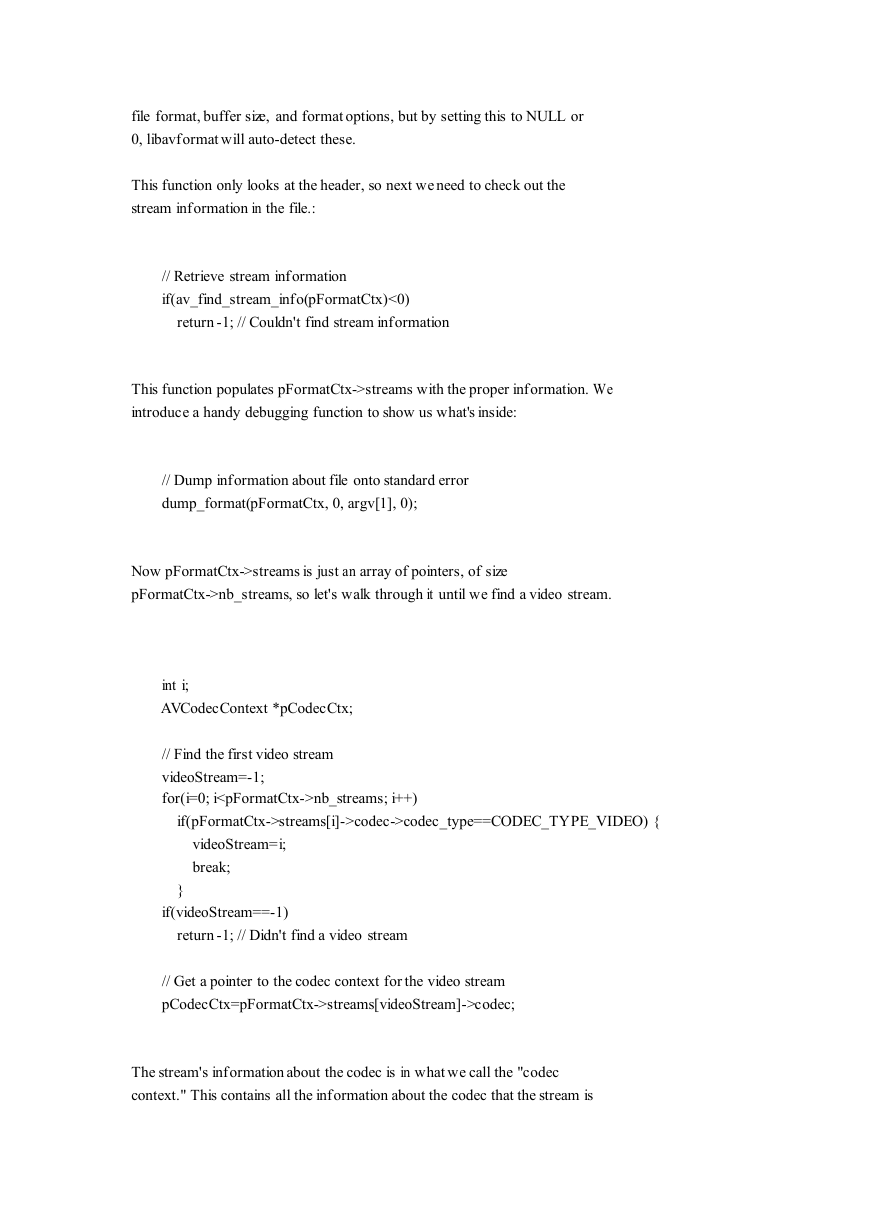
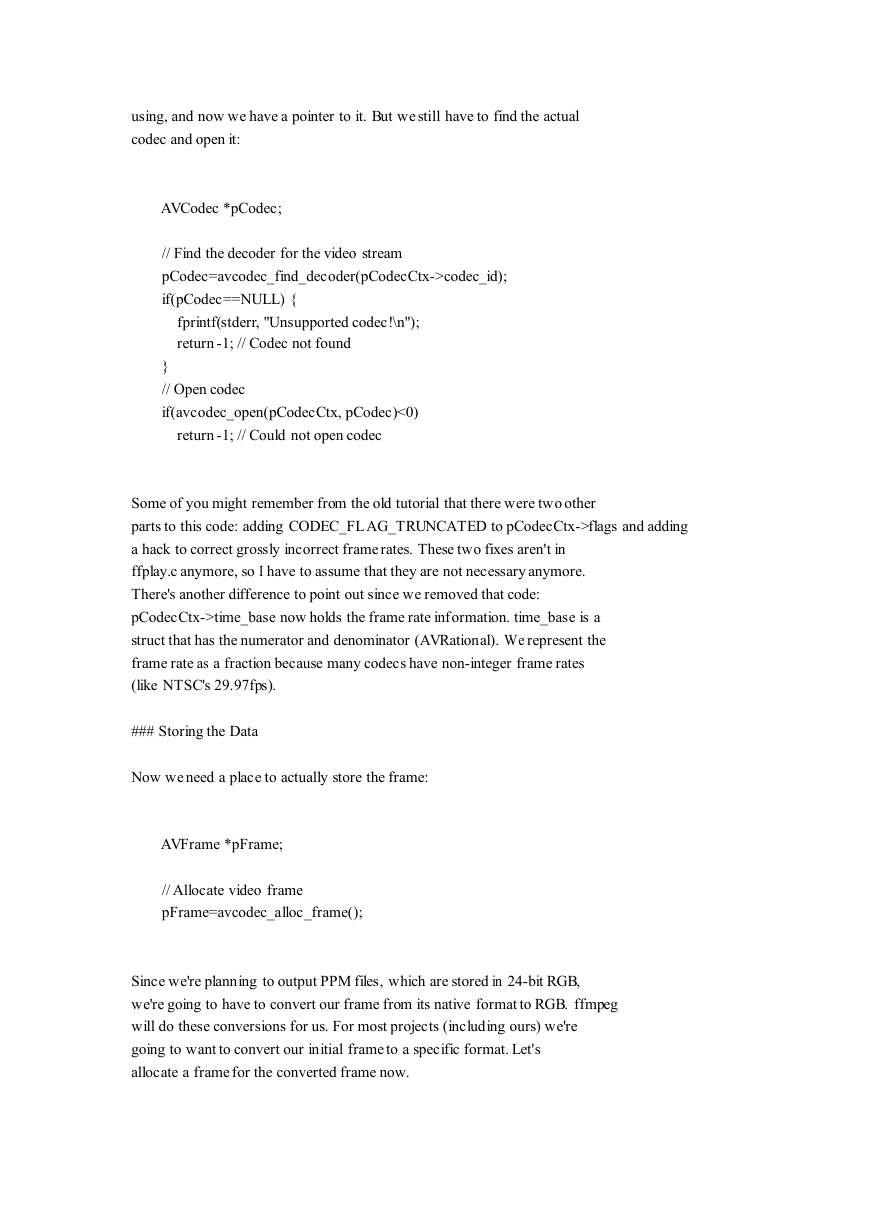
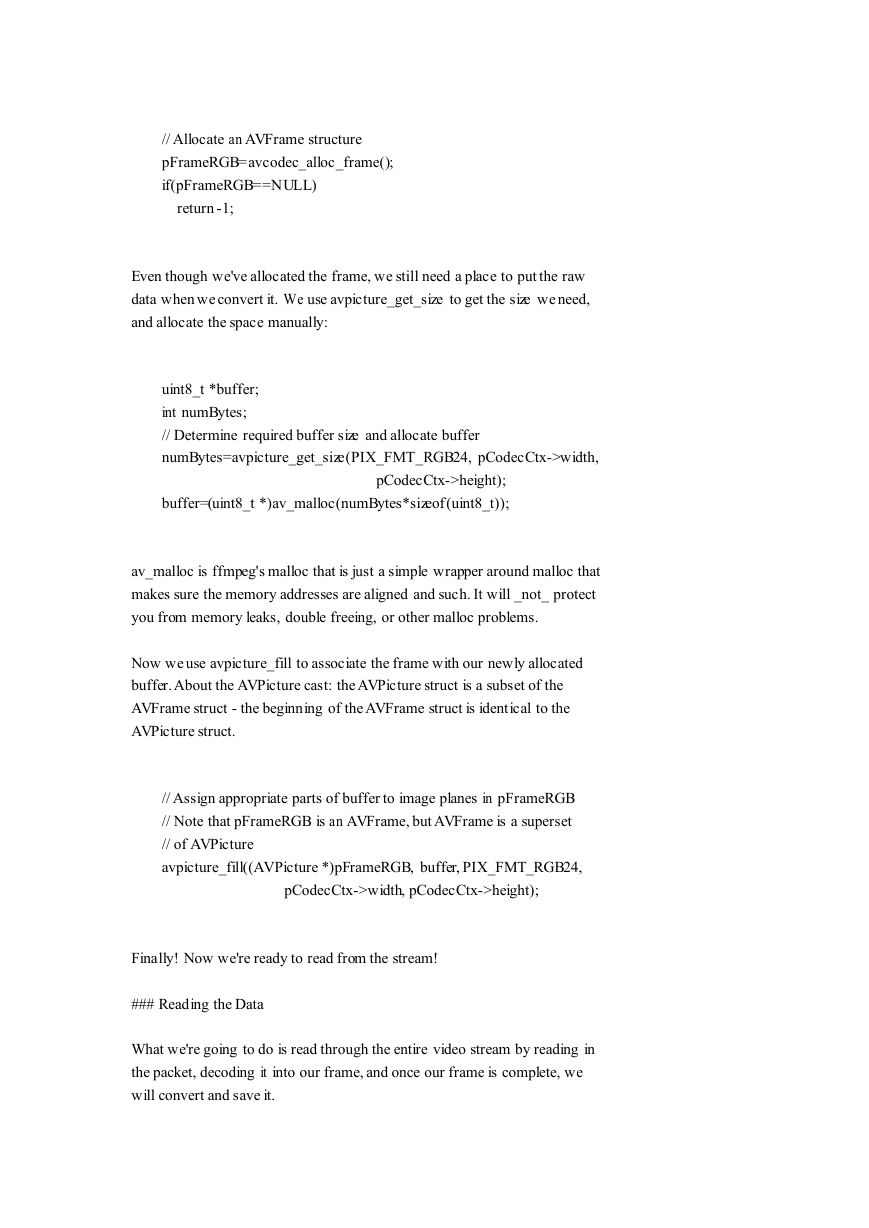
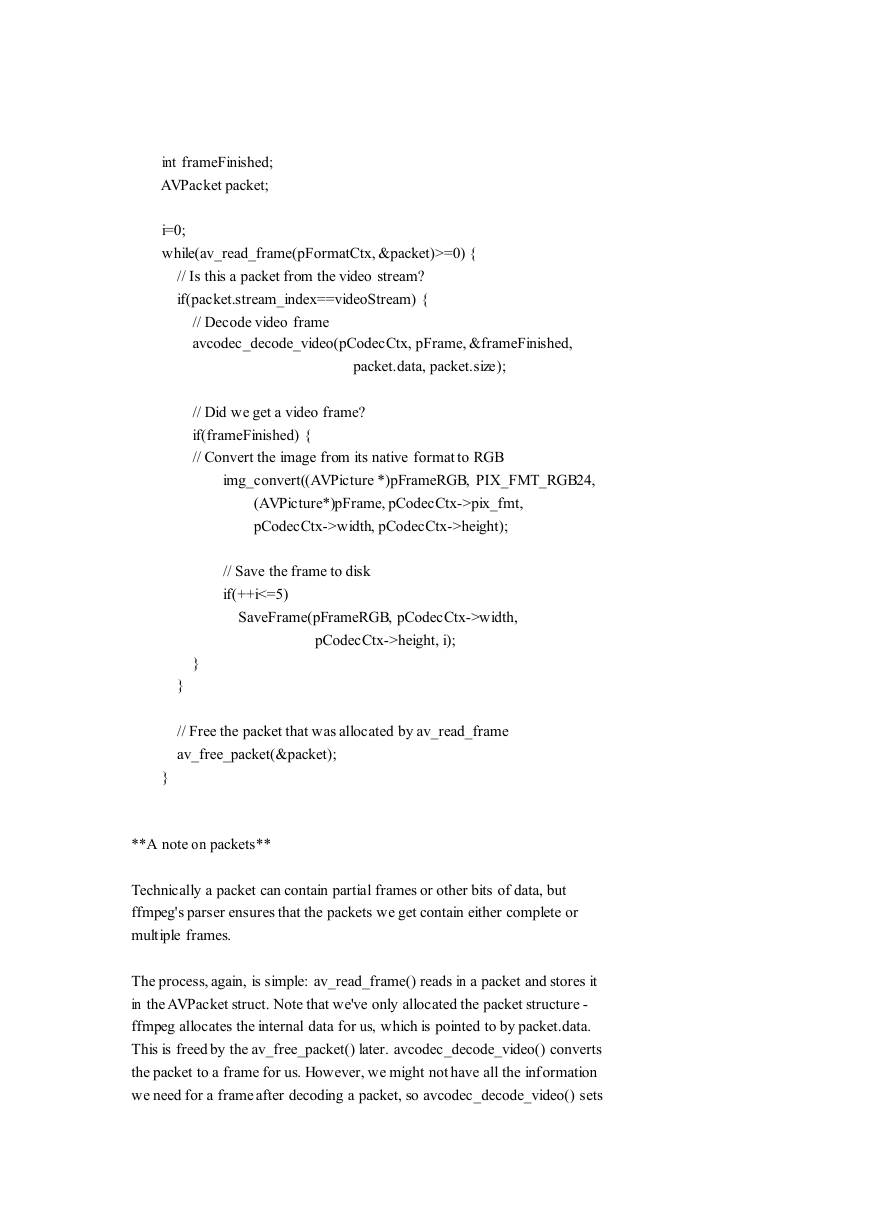
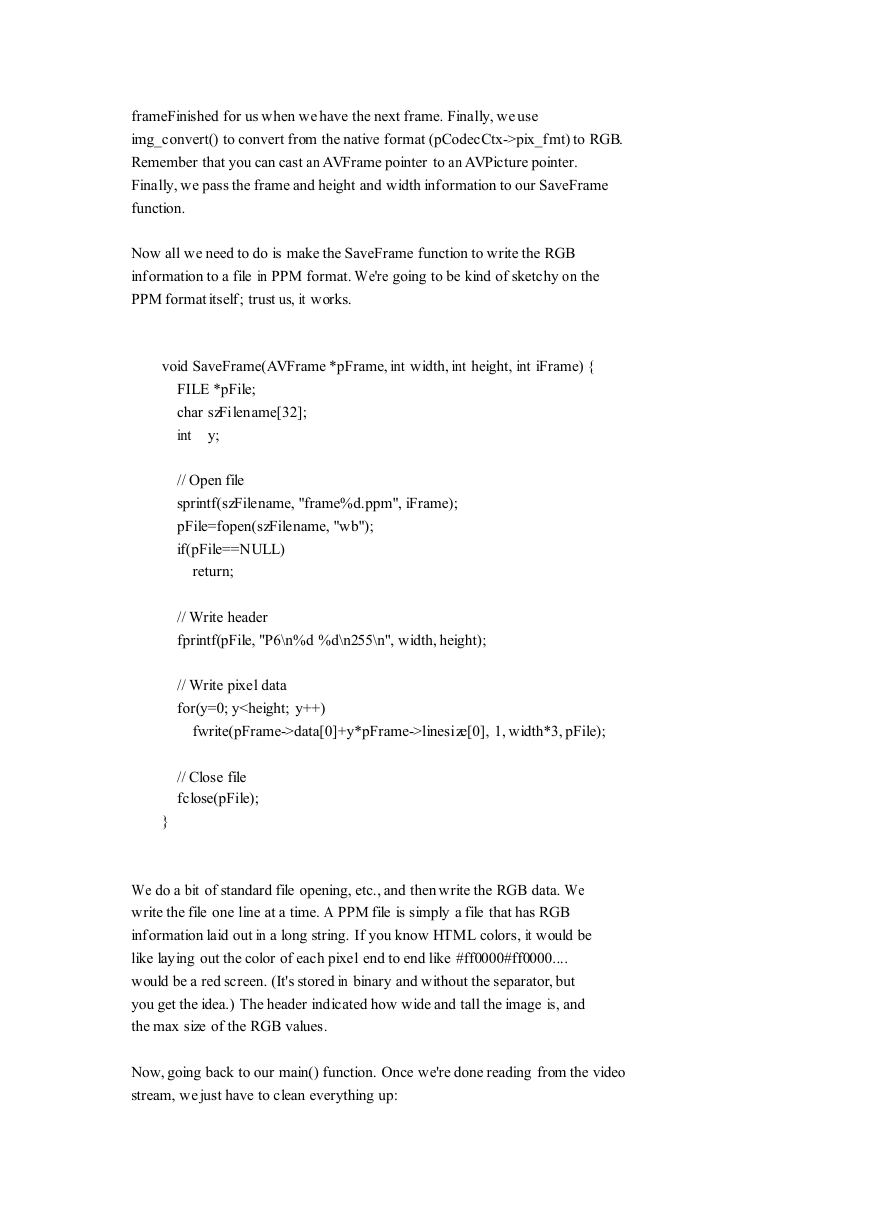








 2023年江西萍乡中考道德与法治真题及答案.doc
2023年江西萍乡中考道德与法治真题及答案.doc 2012年重庆南川中考生物真题及答案.doc
2012年重庆南川中考生物真题及答案.doc 2013年江西师范大学地理学综合及文艺理论基础考研真题.doc
2013年江西师范大学地理学综合及文艺理论基础考研真题.doc 2020年四川甘孜小升初语文真题及答案I卷.doc
2020年四川甘孜小升初语文真题及答案I卷.doc 2020年注册岩土工程师专业基础考试真题及答案.doc
2020年注册岩土工程师专业基础考试真题及答案.doc 2023-2024学年福建省厦门市九年级上学期数学月考试题及答案.doc
2023-2024学年福建省厦门市九年级上学期数学月考试题及答案.doc 2021-2022学年辽宁省沈阳市大东区九年级上学期语文期末试题及答案.doc
2021-2022学年辽宁省沈阳市大东区九年级上学期语文期末试题及答案.doc 2022-2023学年北京东城区初三第一学期物理期末试卷及答案.doc
2022-2023学年北京东城区初三第一学期物理期末试卷及答案.doc 2018上半年江西教师资格初中地理学科知识与教学能力真题及答案.doc
2018上半年江西教师资格初中地理学科知识与教学能力真题及答案.doc 2012年河北国家公务员申论考试真题及答案-省级.doc
2012年河北国家公务员申论考试真题及答案-省级.doc 2020-2021学年江苏省扬州市江都区邵樊片九年级上学期数学第一次质量检测试题及答案.doc
2020-2021学年江苏省扬州市江都区邵樊片九年级上学期数学第一次质量检测试题及答案.doc 2022下半年黑龙江教师资格证中学综合素质真题及答案.doc
2022下半年黑龙江教师资格证中学综合素质真题及答案.doc